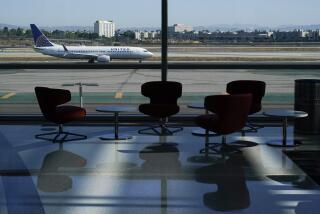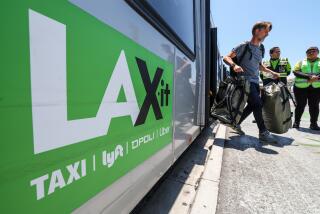Squabbles Keep Burbank Airport Plan Grounded : Expansion Proposal Spurs Disputes Over Noise, Traffic as All Factions Look for a Solution
Fifteen years after it was proposed, the dream of a new terminal at Burbank Airport appears no closer to reality than it was back then--when annual passenger loads were half the current levels and the little-known airfield was perceived as a backwater.
But even though nearly 5 million passengers a year crowd the 65-year-old terminal, political squabbles over noise and traffic keep the vision of a safer, more modern, more spacious facility out of reach. It may be well into the next century before any construction begins.
But there is little disagreement that something must be done.
The airport is close to bursting during heavy travel periods such as now, the week before Christmas. The Federal Aviation Administration has said again and again that the terminal building is too close to the runways. Airlines have little room to grow. And the passenger amenities are less than posh.
“Even if you build nothing, the number of passengers coming through the door will still go up,” airport Executive Director Tom Greer said. “What will the impacts be if we do nothing? Overcrowding will bring code violations. Our sewers will be overloaded. . . . And we are driven by the fact that the FAA has said we cannot do nothing.”
What to do and how to do it, though, remain sticking points. About the only certainty is that someone--some city, some neighborhood, some homeowner--will be left out and angered by whatever happens.
“I would say the whole thing is headed toward litigation,” said Burbank City Councilman Bob Kramer, who opposes current plans for expansion. “The battle is going to continue for the next several years and there are no solutions in sight.”
Critics such as Kramer fear that the airport’s plans for a new 465,000-square-foot terminal--triple the size of the existing building--would mean far more planes making noise in the skies above Burbank and far more passengers clogging city streets. The most vocal opposition comes from the neighborhoods that surround the airport. These areas bear the brunt of most of the noise, which has declined steadily since 1978, according to figures reported to federal officials.
Neighbors in Los Angeles have on three occasions sued and lost in their efforts to block expansion of the airport, which is
bounded on three sides by Los Angeles. They complain that jet noise affects Los Angeles disproportionately because takeoff and landing patterns pass over them more often than Burbank. The case is on appeal.
In Burbank, the City Council has vowed repeatedly to fight expansion at every turn unless the other two cities that govern the airport--Glendale and Pasadena--address Burbank’s concerns. Burbank wants flights restricted during the early morning and overnight, a smaller terminal and protections against heavy traffic. This month, Burbank threatened legal action against the expansion and retained a nationally prominent aviation law firm to protect its interests.
Tense Relations
Burbank’s objections have sparked tensions on the Burbank-Glendale-Pasadena Airport Authority, the three-city board that runs the airport. There has even been accusations that the appointed commission negotiated a land purchase for a new terminal behind Burbank’s back, which further soured the traditionally strong relationship among the cities.
“This is affecting our relationship in a profound way,” said Ted McConkey, a Burbank city councilman elected this year on a tide of anti-airport sentiment. McConkey said the appointed commissioners from the other two cities are acting recklessly in their push to expand the airport. “The cities of Glendale and Pasadena refuse to take any responsibility for their commissioners and it’s having a very chilling impact on our relationship with them,” he said.
But the fighting promises to intensify this week when the Airport Authority meets to discuss, among other things, the purchase from aerospace giant Lockheed Martin of 140 acres next to the airport as a site for a new terminal. The purchase is perceived by opponents as the first step toward construction.
“It’s imminent that the cash deal between Lockheed and the airport will come to fruition very shortly,” said Philip E. Berlin, one of Burbank’s three appointees to the authority board. “Once that happens, it’s all over.”
To an outsider, it might be difficult to understand what all the fuss is about. Projections show that demand for flights out of Burbank will only grow in years to come. Some predict as many as 10 million passengers a year traveling in and out of Burbank by 2010. Already, the concourses are crowded with passengers unable to find chairs during busy morning and afternoon rushes. And behind the scenes, facilities such as baggage handling are crowded and primitive.
Chance of Accidents
Safety experts confirm that a new terminal would reduce the likelihood of catastrophic accidents. The facility spins off millions of dollars in economic benefits to the San Fernando and San Gabriel valleys. And noise at the airport--the cornerstone of the debate--has actually decreased in the 17 years since it was sold to the three cities by Lockheed.
Each side boasts its own sets of numbers to prove or disprove the airport’s potential impacts.
According to data compiled by the airport and reported to the FAA, the area disturbed by what federal officials deem “unacceptable” levels of noise has fallen nearly 95%--from 403 acres in 1978 to less than 28 in 1992--largely due to quieter jets.
Yet at the same time, complaints over noise have jumped all over the map--up one month, down the next and often corresponding to the level of public rancor over airport noise. For instance, complaints more than tripled the month after Burbank’s April municipal elections, when candidates were attacking the airport on the stump and in the press.
Sound is measured by monitoring stations around the airport. Decibel levels are calculated and then averaged out between measurements for the month. Old noise standards held that sustained exposure to 70 decibels--about the level of a normal conversation--or more was excessive. Those standards were lowered to 65 decibels in 1990.
“The planes may be quieter, but they are flying more often and for longer hours,” McConkey said. Another observer posed the question differently: Which would be more annoying, being pelted every minute or so with Ping-Pong balls or every few hours with a basketball?
The airport’s Greer responded that the facility “peaked too soon” by requiring airlines to fly quieter jets into Burbank long before the federal government did so. As a result, there were several years in the late 1980s when jets not only made less noise, but there were less jets to make noise.
Today, about 106 passenger flights leave and land at Burbank daily. Despite its constraints, Burbank remains a convenient alternative to Los Angeles International Airport, particularly for budget-minded travelers to the Bay Area or Sacramento.
Critics of expansion fear that a new terminal with additional gates and more amenities would create a crush of new travelers and new flights, a contention that supporters discount, but that analysts say is, in part, true.
“There’s only so many flights that can fly in and out of the airport every day,” Pasadena Vice Mayor Chris Holden said. “Building a new physical structure in and of itself is not going to increase the noise. You’ll still have the same number of planes taking off and landing.”
Need for Expansion
Phil Roberts, chairman of the consulting firm Roberts, Roach & Associates, said new terminals can create small jumps in demand. “It makes it more attractive to the airlines and to the extent that they can increase service, it increases the number of flights,” he said.
For instance, Southwest Airlines, which handles more flights in and out of Burbank than any other airline, could use additional gates to turn passengers around more quickly and to handle delayed flights that otherwise might clog its system.
“We’d like to spread out our operation to make it more efficient,” spokeswoman Linda Burke-Rutherford said. “We have very tight spaces to deal with. In terms of workers behind the scenes, it’s very tight. A new terminal would give us the opportunity to grow.”
But Burke-Rutherford acknowledged that there is only so much demand for air service in Burbank. Because of restrictions against lengthening the runways, the airport will never serve big jets required for travel overseas. Nor will it likely ever compete against Los Angeles International for long-haul domestic flights.
Emotions Run High
What it does, however, is spin millions of dollars indirectly into the surrounding communities.
About $3.7 million is generated every year through property tax alone. The Burbank Chamber of Commerce has declined to enter the fray directly, in part because its membership’s opinions are as divided as those throughout the rest of the city.
“These debates are generally not settled on economic points,” said Darryl Jenkins, a professor at New York University. “These are always emotional issues.”
The emotions ran so high in recent weeks that Burbank Mayor Dave Golonski proposed a cooling-off period that would allow the three cities to resolve their differences with the help of a mediator. Glendale City Council members have also endorsed the idea. Pasadena has yet to take up the issue.
Yet the debate may quickly turn hot again this week as the authority discusses the possible purchase of the former Skunk Works property north of the terminal as a site for the new facility. In a letter to Burbank Vice Mayor Susan Spanos, Lockheed Martin Vice President Vince Marafino said the company wants to hammer out a deal by the end of the year.
Burbank officials cried foul last month when they learned that Airport Authority representatives from Glendale and Pasadena were meeting with Lockheed Martin, planning the land purchase, in what was perceived as an effort to circumvent Burbank’s opposition.
Burbank’s protests were perceived by officials from the airport and other cities as disingenuous. They pointed out that it has been public knowledge since 1990 that the airport wanted the Lockheed land for a terminal.
Yet for all the hue and cry, the dispute has had little effect on the passengers and regular users of the airport. Limo driver Cy Allen said he knows nothing of the rancor surrounding the expansion project, but said he would like to see a larger terminal.
But passenger Paul Higa, a regular flier from Santa Barbara, said size is irrelevant. “It has to be more efficient, more convenient,” he said. “Expanding alone won’t increase business.”
Times correspondent Steve Ryfle contributed to this story.
More to Read
Sign up for Essential California
The most important California stories and recommendations in your inbox every morning.
You may occasionally receive promotional content from the Los Angeles Times.










